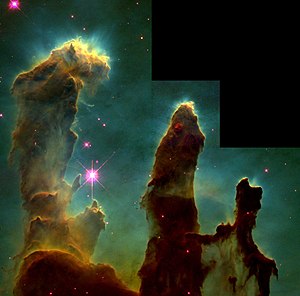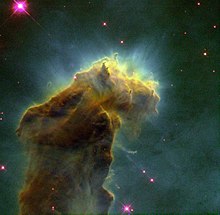
Back Skeppingspilare Afrikaans أعمدة الخلق Arabic Yaradılış sütunları Azerbaijani Слупы стварэння Byelorussian Слупы стварэньня BE-X-OLD Стълбовете на сътворението Bulgarian Stubovi stvaranja BS Pilars de la Creació Catalan Sloupy stvoření Czech Pileri'r Greadigaeth Welsh

(animation; 0:15; 11 November 2022)

Pillars of Creation is a photograph taken by the Hubble Space Telescope of elephant trunks of interstellar gas and dust in the Eagle Nebula, in the Serpens constellation, some 6,500–7,000 light-years (2,000–2,100 pc; 61–66 Em) from Earth.[1] These elephant trunks had been discovered by John Charles Duncan in 1920 on a plate made with the Mount Wilson Observatory 60-inch telescope.[2][3] They are so named because the gas and dust are in the process of creating new stars, while also being eroded by the light from nearby stars that have recently formed.[4]
Taken on April 1, 1995, it was named one of the top ten photographs from Hubble by Space.com.[5] The astronomers responsible for the photo were Jeff Hester and Paul Scowen from Arizona State University. The region was rephotographed by ESA's Herschel Space Observatory in 2011, again by Hubble in 2014 with a newer camera, and the James Webb Space Telescope in 2022.
Released in 2007, Chandra X-ray Observatory (AXAF) had observed the area in 2001. It did not find many X-ray sources in the towers but was able to observe sources at various X-ray energy levels in the area from young stars.[6]
The image is noted for its global culture impact, with National Geographic noting on its 20th anniversary that the image had been featured on everything from "t-shirts to coffee-mugs".[7]
- ^ Clavin, Whitney. "'Elephant Trunks' in Space". Archived from the original on February 5, 2023. Retrieved March 9, 2011.
- ^ Duncan, J. C. (1920). "Bright nebulae and star clusters in Sagittarius and Scutum photographed with the 60-inch reflector". The Astrophysical Journal. 51: 4. Bibcode:1920ApJ....51....4D. doi:10.1086/142519.
- ^ Oliveira, Joana M. (2008). Star Formation in the Eagle Nebula. arXiv:0809.3735. Bibcode:2008hsf2.book..599O.
- ^ Embryonic Stars Emerge from Interstellar "Eggs", Hubble news release
- ^ Best Hubble Space telescope images from Space.com. [archived copy]
- ^ "Chandra :: Photo Album :: The Eagle Nebula (M16) :: 15 Feb 07". chandra.harvard.edu. Retrieved September 17, 2019.
- ^ "Hubble Revisits an Icon, the Pillars of Creation". Science & Innovation. January 5, 2015. Archived from the original on August 4, 2020. Retrieved September 17, 2019.